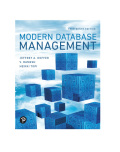
(a)
Define File Organization.
Explanation of Solution
File organization is a process for arranging and organizing files and records in a secondary storage device. Modern
(b)
Define Heap File Organization.
Explanation of Solution
In the Heap file organization, the files and their records are not stored in a particular order. One example for heap file organization is Oracle 12c in which the default table structure is organized in the heap form.
(c)
Define Sequential File Organization.
Explanation of Solution
In the sequential file organization, the file records are stored in a particular order according to the primary key value. To search a particular record, the files are scanned from the beginning until the desired record is located.
(d)
Define Index File Organization.
Explanation of Solution
Index file organization stores the files and records either sequentially or non-sequentially and creates an index to locate individual record with the help of applictaion software. An index is a table that contains index entries matching a key value with one record that contains the location of record.
(e)
Define Hashed File Organization.
Explanation of Solution
Hashed file organization determines the address of each record using the hashing
(f)
Define Denormalization.
Explanation of Solution
Denormalization is a process that transforms the normalized tables into non normalized physical record specification.
(g)
Define Composite key.
Explanation of Solution
Composite key is also known as compound key and is a combination of two or more attributes which combinely identifies a row in the table uniquely.
(h)
Define Secondary Key.
Explanation of Solution
An entity can have multiple choices for primary keys which are collectively known as candidate keys out of which, one is considered as a primary key and other keys which are not selected as primary key are known as secondary keys.
(i)
Define Data Type.
Explanation of Solution
Data type is a detailed coding scheme used to represent organizatonal data and is recognized by system software like DBMS. The pattern of coding scheme is transparent to the user.
(j)
Define Data Dictionary.
Explanation of Solution
Data dictionary is a set of files that contain collection of data which describe the data model. It contains record about the objects in the database.
(k)
Define Transaction log.
Explanation of Solution
Transaction log is an integral and important part of SQL server database. It is a file that contains all the log records of the logging process in SQL server database and plays an important role in the disaster recovery. Every database modification or transaction occurred is recorded in a transaction log.
(l)
Define Encryption.
Explanation of Solution
Encryption is a process of encoding any information or message so that any unauthorized parties cannot access that confidential information.
Want to see more full solutions like this?
Chapter 8 Solutions
Modern Database Management
- "Do not use AI tools. Solve the problem by hand on paper only and upload a photo of your handwritten solution."arrow_forward"Do not use AI tools. Solve the problem by hand on paper only and upload a photo of your handwritten solution."arrow_forward"Do not use AI tools. Solve the problem by hand on paper only and upload a photo of your handwritten solution."arrow_forward
- "Do not use AI tools. Solve the problem by hand on paper only and upload a photo of your handwritten solution."arrow_forwardSolve this "Do not use AI tools. Solve the problem by hand on paper only and upload a photo of your handwritten solution."arrow_forward"Do not use AI tools. Solve the problem by hand on paper only and upload a photo of your handwritten solution."arrow_forward
- "Do not use AI tools. Solve the problem by hand on paper only and upload a photo of your handwritten solution."arrow_forwardSpecifications: Part-1Part-1: DescriptionIn this part of the lab you will build a single operation ALU. This ALU will implement a bitwise left rotation. Forthis lab assignment you are not allowed to use Digital's Arithmetic components.IF YOU ARE FOUND USING THEM, YOU WILL RECEIVE A ZERO FOR LAB2!The ALU you will be implementing consists of two 4-bit inputs (named inA and inB) and one 4-bit output (named out). Your ALU must rotate the bits in inA by the amount given by inB (i.e. 0-15).Part-1: User InterfaceYou are provided an interface file lab2_part1.dig; start Part-1 from this file.NOTE: You are not permitted to edit the content inside the dotted lines rectangle. Part-1: ExampleIn the figure above, the input values that we have selected to test are inA = {inA_3, inA_2, inA_1, inA_0} = {0, 1, 0,0} and inB = {inB_3, inB_2, inB_1, inB_0} = {0, 0, 1, 0}. Therefore, we must rotate the bus 0100 bitwise left by00102, or 2 in base 10, to get {0, 0, 0, 1}. Please note that a rotation left is…arrow_forwardSolve this "Do not use AI tools. Solve the problem by hand on paper only and upload a photo of your handwritten solution."arrow_forward
- Solve this "Do not use AI tools. Solve the problem by hand on paper only and upload a photo of your handwritten solution."arrow_forward"Do not use AI tools. Solve the problem by hand on paper only and upload a photo of your handwritten solution."arrow_forwardSolve this "Do not use AI tools. Solve the problem by hand on paper only and upload a photo of your handwritten solution."arrow_forward

 Principles of Information Systems (MindTap Course...Computer ScienceISBN:9781305971776Author:Ralph Stair, George ReynoldsPublisher:Cengage Learning
Principles of Information Systems (MindTap Course...Computer ScienceISBN:9781305971776Author:Ralph Stair, George ReynoldsPublisher:Cengage Learning Principles of Information Systems (MindTap Course...Computer ScienceISBN:9781285867168Author:Ralph Stair, George ReynoldsPublisher:Cengage Learning
Principles of Information Systems (MindTap Course...Computer ScienceISBN:9781285867168Author:Ralph Stair, George ReynoldsPublisher:Cengage Learning Enhanced Discovering Computers 2017 (Shelly Cashm...Computer ScienceISBN:9781305657458Author:Misty E. Vermaat, Susan L. Sebok, Steven M. Freund, Mark Frydenberg, Jennifer T. CampbellPublisher:Cengage Learning
Enhanced Discovering Computers 2017 (Shelly Cashm...Computer ScienceISBN:9781305657458Author:Misty E. Vermaat, Susan L. Sebok, Steven M. Freund, Mark Frydenberg, Jennifer T. CampbellPublisher:Cengage Learning Fundamentals of Information SystemsComputer ScienceISBN:9781337097536Author:Ralph Stair, George ReynoldsPublisher:Cengage Learning
Fundamentals of Information SystemsComputer ScienceISBN:9781337097536Author:Ralph Stair, George ReynoldsPublisher:Cengage Learning Database Systems: Design, Implementation, & Manag...Computer ScienceISBN:9781305627482Author:Carlos Coronel, Steven MorrisPublisher:Cengage Learning
Database Systems: Design, Implementation, & Manag...Computer ScienceISBN:9781305627482Author:Carlos Coronel, Steven MorrisPublisher:Cengage Learning





